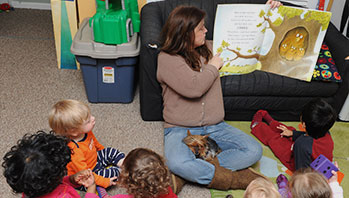- river
- stream
- water
MA Standards:
Literature/RL.PK.MA.1: With prompting and support, ask and answer questions about a story or a poem read aloud.
Literature/RL.PK.MA.10: Listen actively as an individual and as a member of a group to a variety of age-appropriate literature read aloud.
Literature/RL.PK.MA.4: With prompting and support, ask and answer questions about unfamiliar words in a story or poem read aloud.
Literature/RL.PK.MA.9: With prompting and support, make connections between a story or poem and one’s own experiences.
Head Start Outcomes:
Literacy Knowledge/Book Appreciation and Knowledge: Asks and answers questions and makes comments about print materials.
PreK Learning Guidelines:
English Language Arts/Reading and Literature 6: Listen to a wide variety of age appropriate literature read aloud.
English Language Arts/Reading and Literature 10: Engage actively in read-aloud activities by asking questions, offering ideas, predicting or retelling important parts of a story or informational book.
Read Together: Row, Row, Row Your Boat #1

© Commonwealth of Massachusetts, Department of Early Education and Care (Jennifer Waddell photographer). All rights reserved.
ELA Focus Skills: Concepts of Print, Listening and Speaking, Story Comprehension, Vocabulary
Before You Read
Show children the cover of Row, Row, Row Your Boat and have them locate the title. Read the words aloud, tracking them as you do. Ask, What sound do you hear at the beginning of the title words Row, Row, Row? That’s right, it’s the /r/ sound. Say the title again with me: Row, Row, Row Your Boat. Emphasize the /r/ sound.
Read the author’s name and explain that she also drew the pictures. Talk about the cover illustration. Ask, Where are the bears? Guide children to notice the stream that the bears are floating on as they ride in the boat. Ask, What do you know about streams and rivers? How does water move in a stream? How does it move in a river?
As You Read
Read slowly, with rhythm and expression. Hold the book so everyone can see each of the illustrations as you read.
- Review the word row with children. Ask, How are the bears getting down the stream? Use body language and gestures to clarify the meaning of the word row. Say, The bears are rowing their boat down the stream!
- Use the illustrations to clarify the meaning of the words children might use in their science explorations, such as splashing and damming.
After You Read
Talk about the book with children. Ask questions such as,
- Did you like this book? What is your favorite part?
- How do the pictures help you know what words like oars go sailing and shore mean?
- What was it like for the bears to float down the stream? Did the water move the same way the entire time? How did it change?
Take It Further: You may wish to tell children that row has another meaning. Say, In this book, row means “use oars to move a boat.” But we sometimes put chairs in a row, or “a line.” Guide children to understand that the rest of a sentence tells which meaning of a word is being used. Give children sentence examples and work with them to understand which meaning of the word row is used in the sentence.
